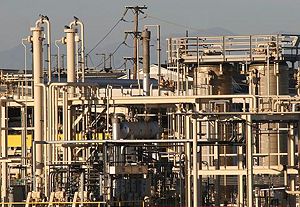User:Milton Beychok/Sandbox
Piping is a system of pipes (hollow, cylindrical tubes) used to convey liquids, gases and sometimes other materials from one location to another within industrial facilities such as petroleum refineries, chemical and petrochemical manufacturing, natural gas processing, electricity-generating power plants and many others. The adjacent photo depicts a complex piping system in an industrial plant.
Industrial plant piping and the accompanying in-line components can be manufactured from various steel alloys, titanium, aluminum, copper, glass or various plastics. The in-line components are known as fittings and valves.
Process control systems use in-line sensors and control valves installed in the piping to monitor and regulate the desired temperatures, pressures, flow rates and process vessel liquid levels of the fluids being transported and processed. Piping and control systems are documented in drawings referred to as Piping and Instrumentation Diagrams.
Piping design
The routing and layout of the pipes fittings in a complex piping system is typically done by experienced piping draftsmen known as piping designers. The discipline of piping design does not require a university degree but it does requires a good many technical skills such as: [1][2]
- The principles and practice of drafting in general.
- The ability to create isometric drawings.
- Familiarity and experience with computerized drafting programs.
- The ability to read process flow diagrams so as to understand the processes within an industrial facility.
- The ability to visualize and develop an industrial facilty plot plan.
- A basic understanding of fluid flow, piping materials and piping specifications.
- An extensive knowledge of piping standards and codes as well as process safety codes and practices.
- A knowledge of the various types of pipe connections such as threaded, welded and flanged connections.
- A basic knowledge of welding practices.
- A knowledge of the various types of valves and why and where they are used.
- A good understanding of pipe stress analysis
Piping designers and pipe stress engineers are responsible for the proper placement of pipe hangers and pipe supports. They are also responsible for making sure that that the thermal expansion and contraction of the piping is compensated for and that the allowable pipe stresses are not exceeded under the appropriate design codes and standards. [3][4] The checking of pipe stresses is usually done with the assistance of a (finite element) pipe stress analysis program such as Caesar II, ROHR2, CAEPIPE and AUTOPIPE.
Plumbing
Plumbing is a piping system that most people are familiar with, as it constitutes the form of fluid transportation that is used to provide potable water and fuels to their homes and business. Plumbing pipes also remove waste in the form of sewage, and allow venting of sewage gases to the outdoors. Fire sprinkler systems also use piping, and may transport potable or nonpotable water, or other fire-suppression fluids.
See also
- Hydrogen piping
- Hydrostatic test
- Piping and plumbing fittings
- Hydraulic pipes
- Plastic Pressure Pipe Systems
- Riser clamp
- Firestop
- Thermal insulation
References
- ↑ Editors: Perry, R.H. and Green, D.W. (1984). Perry's Chemical Engineers' Handbook, 6th Edition. McGraw-Hill Book Company. ISBN 0-07-049479-7.
- ↑ Editor: McKetta, John J. (1992). Piping Design Handbook. Marcel Dekker, Inc.. ISBN 0-8247-8570-3.
- ↑ Process Piping: ASME B31.3
- ↑ Power Piping: ASME B31.1
Further reading
- ASME B31.3 Process Piping Guide, Revision 1 from Los Alamos National Laboratory Engineering Standards Manual OST220-03-01-ESM
- Seismic Design and Retrofit of Piping Systems, July 2002 from American Lifelines Alliance website
- Engineering and Design, Liquid Process Piping U.S. Army Corps of Engineers, EM 1110-l-4008, May 1999
